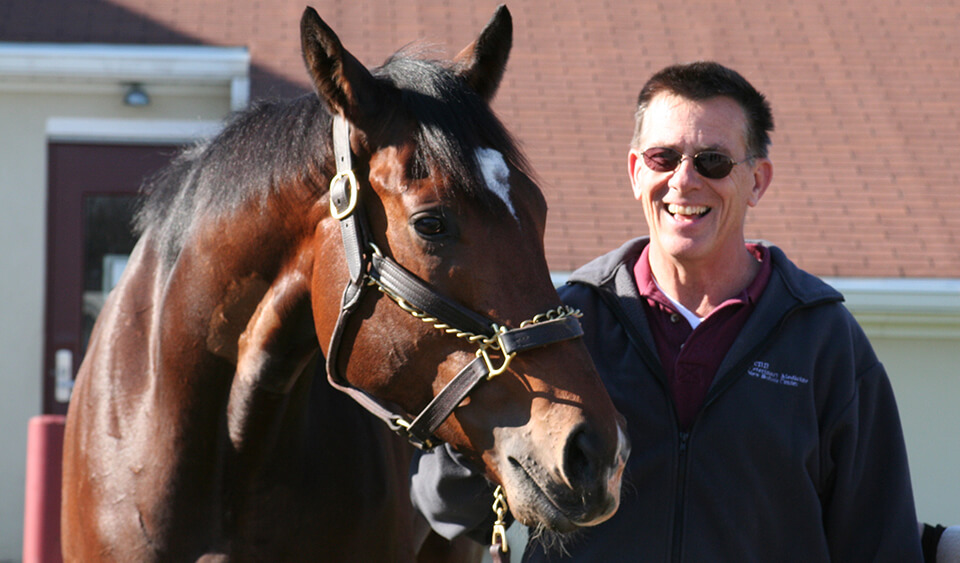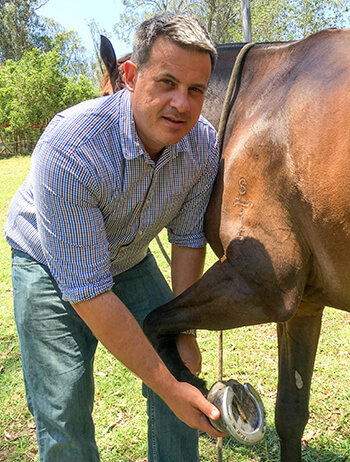 Dr. Dean Richardson and Barbaro pictured above; below, Dr. Andrew van Eps
Dr. Dean Richardson and Barbaro pictured above; below, Dr. Andrew van Eps
In 2006, Dr. Andrew van Eps was a resident
at Penn Vet’s New Bolton Center when
Kentucky Derby winner Barbaro arrived
with a broken leg sustained in the Preakness.
Though Dr. Dean Richardson, the Charles
W. Raker Professor of Equine Surgery, was
able to repair the jigsaw-puzzle-like fracture,
the New Bolton Center team was not able
to spare the horse from the laminitis that
followed.
In late 2016, van Eps returned to Penn
Vet after working at the University of
Queensland in Australia, where he made
significant progress in identifying strategies
to prevent and treat acute laminitis.
Now Associate Professor of Equine
Musculoskeletal Research at New Bolton
Center, he is determined to continue
advancing understanding of the condition’s
underlying causes, and to capitalize on that
knowledge to develop improved, practical
treatments.
“Although I always had a strong interest
in research, it took a back seat to clinics,
teaching, and administrative work in recent
years,” he said. “The position at New
Bolton Center allows me to prioritize
research, which for me is very exciting.”
 More than a decade ago, New Bolton
Center was also his choice destination for his
residency, as he considered it “the best place
in the world to train in large animal internal
medicine.”
More than a decade ago, New Bolton
Center was also his choice destination for his
residency, as he considered it “the best place
in the world to train in large animal internal
medicine.”
Learning from highly regarded clinicians
such as Richardson, van Eps saw that
impressive surgical skills could bring horses
back from seemingly devastating injuries.
But he also observed that, for some horses,
surgery wasn’t enough. “You’d always have
this specter of laminitis looming,” he said.
In the intervening decade, van Eps and
others in the field have explored the nuances
of laminitis.
“We’ve done a lot of good work over the
last 10 years, since Barbaro,” van Eps noted.
“We know now that there are different
mechanisms that can lead to the disease,
and we’re working out ways to prevent or
ameliorate the different forms.”
Laminitis can manifest as any of three
different types, van Eps explained. Barbaro
suffered from what is known as supportinglimb
laminitis, where an injury to one leg
causes the opposite leg to support more
weight than usual, leading to the disease.
Far more common, however, is a form
of laminitis triggered by overproduction of
insulin.
“It’s a little similar to type 2 diabetes in
people,” van Eps said. “The difference is,
people will stop producing insulin, while
horses and ponies just keep making it, and
that insulin triggers changes in the feet of
these animals.”
Laminitis can also arise in horses with
systemic disease, such as colitis or sepsis. For
this third form, van Eps has made major
progress in treatment, using foot cooling,
or cryotherapy, to effectively stop and even
partially reverse damage in affected animals.
With the supporting-limb form of
laminitis, van Eps is partnering with
colleagues to develop mechanical
interventions that address what they believe
to be the root cause of disease—namely
disturbances to blood flow that occur when
the horse’s ability to cycle weight bearing
among its limbs is impaired.
“We’re very excited to use the robotic
CT here at New Bolton to do some studies
that look at blood flow and weight bearing
in standing horses,” he said.
Additionally, van Eps is continuing to
probe the underlying molecular events that
contribute to the metabolic form of disease,
including finding potential drugs to block
the insulin-triggered pathways that can lead
to problems in the foot. He also hopes to
test whether the foot cooling method could
help in this form of laminitis, as it does in
horses with systemic illness.
With this many-pronged attack, van Eps
is working to make a difference to horses of
all stripes, from Triple Crown contenders
to pastured ponies. And he says a lot of the
advancements owe a debt to Barbaro.
“After his case, there was an exponential
increase in interest and funding in laminitis,
and we owe a lot to Roy and Gretchen
Jackson, his owners,” van Eps noted. “Our
progress is part of the Barbaro legacy.”